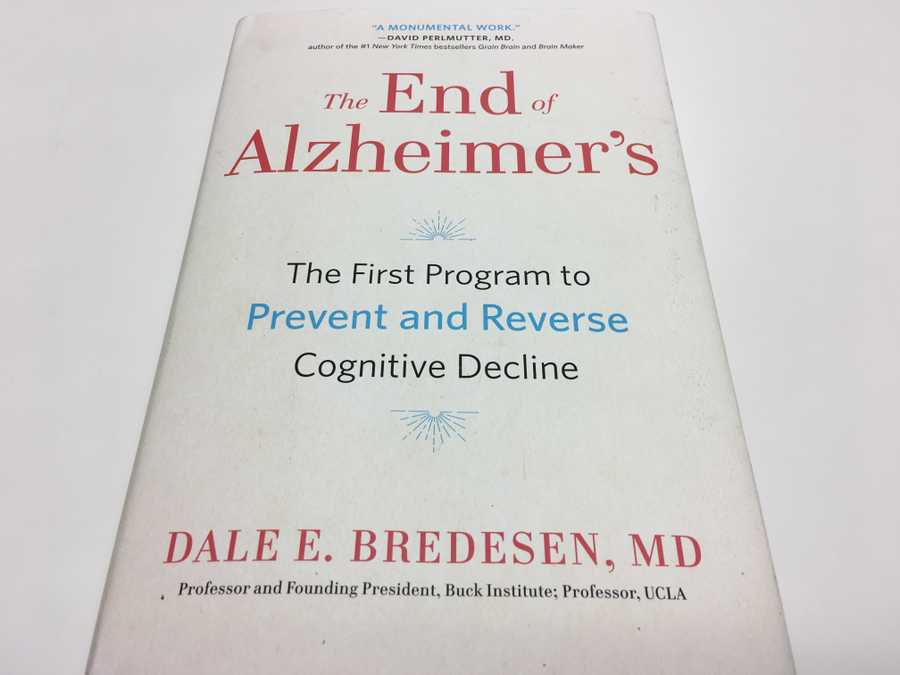The End of Alzheimer's
by Amylee Amos PhD, RDN, IFMCPNews
Everyone knows a cancer survivor, nobody knows an Alzheimer’s survivor… until now.
In August 2017 Dale E. Bredesen, MD published his book, The End of Alzheimer’s: The First Program to Prevent and Reverse Cognitive Decline. It became an instant NY Times bestseller, and for good reason. If you have a loved one with Alzheimer’s disease, if you have a family history of dementia or known genetic risk, or if you just want to avoid devastating cognitive loss, drop everything and go read this book.
We, as a society are terrified of this disease, and we should be. The rates of Alzheimer’s disease and cognitive decline are soaring. It’s estimated that 5.5 million Americans are living with Alzheimer’s disease, and this patient base makes up 1 in 10 adults over the age of 65 (1). What we are doing to attenuate this health crisis is not working. The billions of dollars we’re spending in research to find pharmaceuticals to stop the progression of Alzheimer’s have resulted in a couple of drugs that can only minimally slow the progression of the disease, but that do absolutely nothing to stop it or reverse it (and on top of that they come with a host nasty side effects). Compared with the improvements modern medicine has made with cancer, heart disease, and HIV/AIDS, Alzheimer’s disease treatment is a monumental failure. In fact, Bredesen points out that of the ten leading causes of death in the United States, Alzheimer’s disease is the only one for which there is no effective treatment. Perhaps the issue is that our conventional, mono therapeutic approach to this incredibly complex disease is not complex enough (2).
Bredesen deliniates that the well understood amyloid hypothesis of Alzheimer’s, that the disease is caused by the buildup of amyloid plaques in the brain, does not look deep enough. In other words, we haven’t asked the question of why the amyloid plaques are present in the first place, so we haven’t addressed the root cause of disease. The book elaborates extensively, explaining that finding the root cause has been challenging because Alzheimer’s is not a single disease. Rather, there are three distinctly different subtypes of the disease, all with similar symptoms that we call Alzheimer’s disease. By addressing the specific root causes of the Alzheimer’s symptoms in an individual, the disease can be prevented, stopped, and reversed.
Walking you through the decades of research that went into the development of his protocol, Bredesen highlights the three major metabolic imbalances that contribute to Alzheimer’s disease:
- Inflammation from things like poor diet and lifestyle choices, infection, and other issues
- Trophic loss, or an insufficient amount of supportive factors like hormones, nutrients, and brain supporting compounds
- Toxic exposure from heavy metals like mercury, arsenic, or lead, and biotoxins like mold and other microbes
These three imbalances create the different subtypes of Alzheimer’s disease:
- Type 1: Inflammatory
This type of Alzheimer's occurs more often in people who carry the ApoE4 allele. It is associated with increased biomarkers of inflammation and insulin resistance.
- Type 2: Atrophic
This type of Alzheimer's disease is also correlated with the ApoE4 allele. It is associated with suboptimal levels of brain supporting molecules, like nutrients, hormones, and brain growth factors.
- Type 3: Toxic
This type of Alzheimer's disease is more common in individuals who do not carry ApoE4, and rather carry the ApoE3, neutral risk allele. Symptoms often occur earlier in life than the other types of AD. Type 3 is associated with high blood levels of toxic chemicals.
What this development means, is that Alzheimer’s disease is made up of treatable imbalances. Once treated, the patient improves. That may sound obvious, but this is monumental because we are talking about Alzheimer’s, which up until now was believed to be entirely untreatable.
This book, and Dale Bredesen's research, dramatically changes the way we view Alzheimer’s disease. Under the current, conventional treatment of Alzheimer's, we do not intervene in any way until we see symptoms begin to manifest. Imagine if we treated cancer the same way? By the time we see symptoms of cancer, the disease is well progressed. The same is true for Alzheimer’s. We should be taking action far before symptoms are present, because the disease is taking hold decades before we see those symptoms.
And the crazy part is, the treatment for this devastating and complex disease is nearly entirely lifestyle interventions. It’s changing your diet so that you’re eating real foods that fuel your body and so that you’re not eating foods that drive insulin resistance and inflammation; it’s exercising to maintain good physical health and boost levels of brain growth factors; it’s sleeping enough so that your brain can take out the cellular trash as you sleep; it’s managing your stress to balance your hormone levels and maintain a healthy mental state. It’s all things that you can do yourself.
At the Amos Institute we specialize in implementing the Bredesen Protocol, so we are constantly talking about Dr. Bredesen's research, but the publication of this book is bringing the hope of this research to the masses. If you have not already, please go read this book and immerse yourself in the most hopeful science you may ever encounter. Alzheimer’s disease is preventable. Alzheimer's disease is reversible. With this protocol, Alzheimer's can and will be a disease of the past.
References:
- Alzheimer’s Association (2018). 2017 Alzheimer's Disease Facts and Figures. Retrieved from https://www.alz.org/facts/
- Bredesen, D.E. The End of Alzheimer’s: The First Program to Prevent and Reverse Cognitive Decline. New York: Avery, 2017.